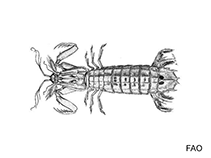Squilla cadenati Manning, 1970
Angolan mantis shrimpWarning: DOMDocument::load(): SSL operation failed with code 1. OpenSSL Error messages: error:140770FC:SSL routines:SSL23_GET_SERVER_HELLO:unknown protocol in C:\Apache24\htdocs\includes\SpeciesSummary.lib.php on line 1236
Warning: DOMDocument::load(): Failed to enable crypto in C:\Apache24\htdocs\includes\SpeciesSummary.lib.php on line 1236
Warning: DOMDocument::load(https://sealifebase.nrm.se/webservice/AquaMaps/getAMap.php?genus=Squilla&species=cadenati): failed to open stream: operation failed in C:\Apache24\htdocs\includes\SpeciesSummary.lib.php on line 1236
Warning: DOMDocument::load(): I/O warning : failed to load external entity "https://sealifebase.nrm.se/webservice/AquaMaps/getAMap.php?genus=Squilla&species=cadenati" in C:\Apache24\htdocs\includes\SpeciesSummary.lib.php on line 1236
Uploaden van je Foto's
Google afbeelding | No image available for this species;
drawing shows typical species in Squillidae.
Google afbeelding | No image available for this species;
drawing shows typical species in Squillidae.
Classification / Names Common names | Synonyms | CoL | ITIS | WoRMS
| Stomatopoda | Squillidae
Environment: milieu / climate zone / depth range / distribution range Ecologie
; diepteverspreiding 37 - 300 m (Ref. 436). Tropical
Verspreiding Landen | FAO regio's | Ecosystems | Voorkomen | Introducties
Eastern Atlantic: Off West Africa, from Senegal to Angola.
Length at first maturity / Size / Gewicht / Leeftijd
Maturity: Lm ? range ? - ? cm Max length : 17.0 cm BL mannelijk/geslacht niet bekend; (Ref. 417); common length : 15.0 cm BL mannelijk/geslacht niet bekend; (Ref. 436)
Korte beschrijving Morfologie
A moderately sized stomatopod. Body with conspicuous longitudinal ridges: sub median ridges of fifth abdominal segment with posterior spines; tail segment with a distinct median ridge. Claws large, armed with 6 spines on the terminal segment. Color: telson with a pair of dark triangle anteriorly, bright red in life (Ref. 436).
Found at depths of 37 to 300 m (Ref. 436).
Life cycle and mating behavior Geslachtsrijpheid | Voortplanting | Kuitschieten | Eieren | Fecundity | Larven
Some members of the order Stomatopoda pair for life and some come together only to mate. Males produce sperm ducts rather than spermatophores; females can brood a maximum of 50,000 eggs. Life cycle: Eggs hatch to a planktonic zoea which lasts for 3 months.
Voornaamste referentie
Referenties | Coördinator | Medewerkers
Schneider, W. 1990. (Ref. 417)
Status op de Rode Lijst van het IUCN (Ref. 130435)
Status bij CITES (Ref. 108899)
Not Evaluated
CMS (Ref. 116361)
Not Evaluated
Gevaarlijk voor mensen
Harmless
Gebruik door de mens
| FishSource |
Tools
Meer informatie
Populaire namen
Synoniemen
Predators
Voortplanting
Geslachtsrijpheid
Kuitschieten
Fecundity
Eieren
Ontwikkeling van de eieren
Synoniemen
Predators
Voortplanting
Geslachtsrijpheid
Kuitschieten
Fecundity
Eieren
Ontwikkeling van de eieren
Internet-bronnen
BHL | BOLD Systems | CISTI | DiscoverLife | FAO(Publication : search) | Fishipedia | GenBank (genoom, nucleotide) | GloBI | Gomexsi | Google Books | Google Scholar | Google | PubMed | Tree of Life | Wikipedia (ga naar, zoek) | Zoological Record
Estimates based on models
Preferred temperature
(Ref. 115969): 14.2 - 17.8, mean 16.3 (based on 35 cells).
Prijsklasse
(Ref. 80766):
Unknown.



